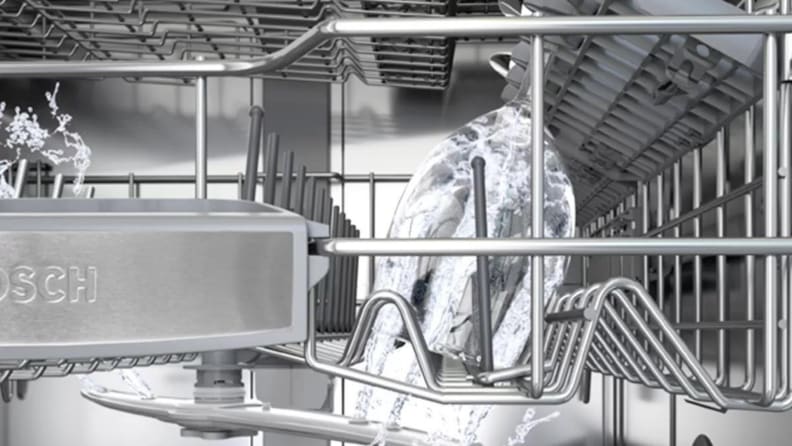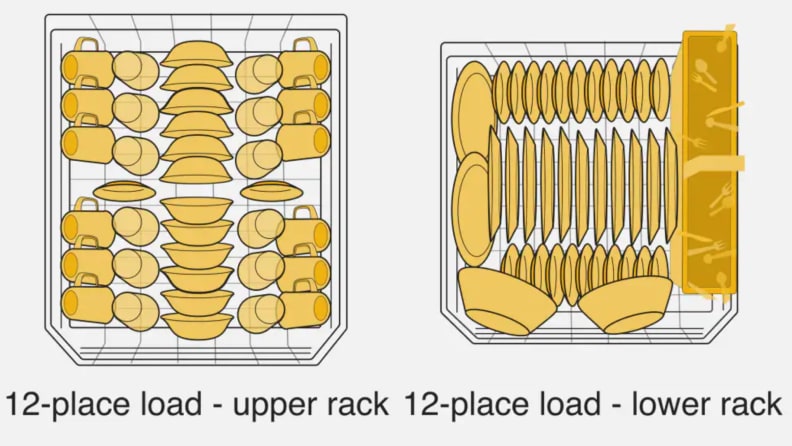Products are chosen independently by our editors. Purchases made through our links may earn us a commission.
Dishwashers save us water, time, and a whole lot of hassle at the end of the day. Not to mention no more seriously chapped hands in the winter. However, opening up your dishwasher after a cycle only to discover a load of half-cleaned dishes is disappointing and really rather annoying.
While you may initially worry that there’s something wrong with your dishwasher, the problem could be a little less obvious and a lot less expensive to fix. You may be loading your dishwasher all wrong.
Putting dishes, pans, and utensils into the dishwasher seems like a straightforward task, but in order to optimize cleaning, there is a right way to do it and plenty of wrong ways.
Our Senior Manager of Lab Operations, Jonathan Chan has tested a lot of dishwashers, so he’s loaded a lot of them, too. He says there’s one place that’s always good to start: “Look in the manual.” If you tossed away your user’s manual long ago, most manufacturers have them online. In the manual’s you can find exactly how the designers intended their machines to be loaded.
In our quest for food-stain-free bowls, we looked to our favorite dishwasher brands for their expertise on the best way to load a dishwasher.
Step 1: Scrape plates clean

You should always to scrape off the larger food scraps into the trash, because food particles can will clog up the filter with food.
Part of the joy of a dishwasher is that it saves you time and water. To maximize the potential of this, don’t worry about a pre-rinse under the faucet. It wastes water on a job that your dishwasher is equipped to wipe clean.
However, as Bosch notes, you should always to scrape off the larger food scraps into the trash, because food particles can clog up the filter with food and result in debris being left.
Step 2: Separate your dishes
Just like you separate your lights and darks when doing laundry, you should separate your dishes by top-rack or bottom-rack items.
GE recommends that you reserve the top rack of your dishwasher for glasses, cups, and saucers, dishwasher-safe plastics, oversized utensils, saucepans and mixing bowls, and wine glasses, as long as they aren’t tall enough to touch the top of the dishwasher.
On the bottom rack, you’ll want to store all silverware, plates, saucers and cookware (think big pots), large items, like dishwasher safe cutting boards, and large platters, pots and bowls—keep these on the sides, in the corners or in the back
Many dishwashers come with special features to fit specific items that go on top and bottom racks. For example Whirlpool recommends that stemware should be secured with the attached stemware holders so they don’t tip over and break during a cleaning cycle.
Some also feature a third rack that is specially designed to get your utensils sparkling clean. This extra rack replaces the need for a traditional cutlery basket. Chan says, “The cutlery basket is faster to load, but the third rack typically gives a better clean.”
Additionally you’ll find that the tines on some dishwasher racks can fold down. This is particularly helpful when loading in pots and pans, rather than plates.
Step 3: Place your dishes properly

When loading your dishwasher, stemware should be secured with the attached stemware holders so they don’t tip over and break during a cleaning cycle.
Once you know where all of your items should go in the dishwasher, focus your attention to which direction your dishes face.
Bosch says that its dishwasher spray arms live under the racks and spray upward. This means that dishes should be facing downward to get best results.
Dishes such as plates, which stand up vertically in the dishwasher, should face toward the center and at an angle. Bowls should either be face down or angled at least 45 degrees downward. This helps dishes get the most water streamed at them, while also allowing for proper draining once the drying process begins. You don’t want to unload the dishwasher and be met with bowls filled with water.
Avoid any overlap between the dishes, so there’s plenty of room for water to stream through and effectively wash off messes.
According to GE, the longstanding rule that you must separate your forks, spoons and knives in the utensil basket is no longer necessary. Your everyday utensils can intermingle and will still get plenty clean.
Step 4: Clear the way for the water jets
When loading your dishes, be wary of blocking off the streams of water or the detergent tray.
If your detergent tray is on the door of your dishwasher, avoid putting any tall sheet pans or cutting boards right up front, because they can block the detergent from opening during a cycle.
Additionally, keep utensils or mug handles from dangling below the racks, or oversized plates from standing too tall. The arms on your dishwasher that contain the water jets spin during the cycle, so any object that gets in the way will prevent the arms from spinning all the way around and spraying your dishes with water.
An exception to this rule is bottle jets. These water jets are designed specifically to have water bottles, baby bottles, travel mugs, and flutes covering them so that the water can reach the bottom of these vessels for a thorough wash.
Step 5. Don’t overload your dishwasher

Most dishwashers can hold enough dishes to serve from to 12 to 14 people.
It may seem like the answer is to run smaller loads to allow your dishes to get cleaner, but this will just waste water. Always run your dishwasher when it’s full, but not overfilled. A good rule of thumb to know when your dishwasher is ready to run is that you can’t add another item without one dish overlapping another dish.
If you’re looking for a little more guidance, your dishwasher should specify how many place settings it holds. A place setting includes a plate, saucer, mug, cup, small bowl, fork, knife, and spoon. Most dishwashers are between 12 and 14 place settings, so that means the dishwasher can hold between 12 and 14 of each of those items.
This can help give you a general idea of how many dishes your dishwasher can handle.
Step 6. Add your detergent and start the cycle
Once you’ve loaded your dishwasher with confidence, it’s time to start the cycle. A good detergent will help ensure ultra clean dishes.
We’ve found that detergent tabs or gel packs will result in the cleanest washing, but powder can also work for those with hard water.
Once you’ve hit start on the cycle, kick back and relax until your dish cycle is clean and dry and ready to be put away.


